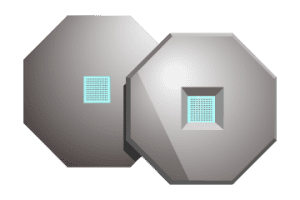
Exploring 4 Applications of Silicon Nitride Thin Film Windows in Bioscience

Silicon nitride thin film windows are window materials with high transparency, chemical stability and mechanical strength. This material has a wide range of applications in bioscience research, mainly because of its good optical properties and biocompatibility. Let's take a look at a few typical scenarios of silicon nitride thin film windows for bioscience applications.
Applications in Life Sciences
Cell imaging and analysis
One of the most important applications of silicon nitride thin-film windows in the biological sciences is the imaging and analysis of cells. Silicon nitride windows provide a transparent, biocompatible surface that allows researchers to observe living cells and study their behavior over time. Using silicon nitride windows, researchers can observe cellular processes that are important for studying cell development, growth, differentiation and disease onset. Analysis at the single-cell level allows for a more refined study of cellular properties, thus advancing research in the biomedical field. The main tools for single-cell analysis include single-cell RNA sequencing, single-cell proteomics, and single-cell metabolomics.
One of the most famous cases in cell imaging and analysis is the Single Molecule Fluorescence Microscopy technique implemented with silicon nitride thin film windows. First invented in 1990 by Professors W.E. Moerner of Stanford University and M. Orrit of Bell Labs, this technique is one of the key techniques for achieving high-resolution imaging of individual molecules.
In single-molecule fluorescence microscopy technology, silicon nitride thin-film windows are used as sample support membranes to enable high-resolution imaging of intracellular molecules. This technique is important for studying the spatial distribution of molecules, molecular interactions, and molecular dynamics in cellular life processes. By using silicon nitride thin-film windows, the interference of optical noise and background signals can be reduced and the signal-to-noise ratio of imaging can be improved, thus achieving highly sensitive single-molecule imaging.
Cell imaging is one of the very important tools in bioscience research. Due to the transparency of silicon nitride thin film windows, it can be used as a window material for microscopy. When a sample is placed under a microscope for imaging, the silicon nitride window will play a key role in protecting the sample without compromising the quality and accuracy of the imaging.
In recent years, with the continuous development of single-molecule fluorescence microscopy technology, silicon nitride thin-film windows have been widely used in many important studies in the field of cell imaging, such as the study of protein dynamics, the study of intracellular signal transduction mechanisms, and the study of neuronal axon synaptic connections.
DNA and protein analysis
Silicon nitride thin-film windows can be used for molecular diagnostics, such as the detection of fluorescently labeled protein or DNA molecules. Fluorescence-based molecular assays have been widely used for studies at the cellular and molecular levels, such as detecting intracellular protein and DNA expression, changes in cell function, etc. Using silicon nitride thin-film windows, these assays can be performed under non-destructive conditions, while also greatly improving the sensitivity and accuracy of the assay.

Drug Development
Silicon nitride thin-film windows are also becoming more widely used in drug development. Researchers can use silicon nitride thin-film windows to observe the action, effects and side effects of drugs in cells.
For example, a paper published in ACS Sensors in 2019 is titled "Programmable microenvironmental chips for studying the response of chemotherapy drugs to liver cancer cells. The team used silicon nitride thin-film windows to create programmable microenvironmental chips for studying the response of liver cancer cells to different chemotherapeutic drugs. In this study, the silicon nitride thin-film window enables imaging and tracking of cells, and by controlling the microenvironment of cell culture, researchers can more accurately assess the efficacy and toxicity of different chemotherapeutic drugs, providing a new idea for liver cancer treatment.
Another classic example is a paper published in Analytical Chemistry in 2020 entitled "Drug screening and efficacy evaluation using microchips and imaging". The team used silicon nitride thin-film windows to create microchips that integrate multiple small chambers and cell culture areas into a single chip, allowing for the screening and efficacy evaluation of multiple drugs. The researchers performed cell imaging through the silicon nitride thin-film windows to observe the growth and changes of cells, which can evaluate the efficacy and toxicity of drugs. The use of such microchips can not only greatly improve the efficiency of drug development, but also reduce the cost of drug development.
In addition, it is possible to observe how drugs are transported inside cells and how they interact with specific receptors. This information can help researchers better understand the mechanism of action of drugs and design more precise molecular structures of drugs, thus improving their efficacy and safety.
Biosensors
Biosensors are analytical devices that detect biological analytes and convert them into measurable signals. It enables quantitative and qualitative analysis and detection of biomolecules by detecting the interactions between biomolecules and biological systems. Silicon nitride thin film windows have excellent light transmission and can be used for the detection of fluorescent probes. In addition, the hydrophilicity and chemical stability of the silicon nitride thin film window surface can ensure the sensitivity and stability of the biosensor.
In recent years, silicon nitride thin-film windows have gained more and more attention in the application of biosensors. For example, they have been used in protein enzymatic digestion, drug screening, microbial detection, DNA detection, etc., and have achieved more significant application results. At the same time, the processability of silicon nitride thin film windows can also meet the needs of biosensor manufacturing, providing a good basis for the further development of biosensors.

In summary, cell imaging and analysis, DNA and protein analysis, drug development and biosensors are extremely important areas in bioscience. In these fields, silicon nitride thin-film windows play an increasingly important role. Their high quality, transparency and durability provide researchers with an excellent experimental tool. Through the application of silicon nitride thin-film windows, researchers can better observe and study the behavior of cells, molecules and drugs in biological systems, thus providing more in-depth and precise data and information for research in the biosciences.
We offer customization services for silicon nitride thin film windows / MEMS, please feel free to contact us.
Related Products
Related Reading
Electron Beam Evaporation Coating (EB-PVD) Processes and Advantages and Disadvantages
Processes and Advantages of Electron Beam Evaporation Coating (EB-PVD) Electron Beam
Magnetron sputtering丨influence on the quality of thin films
Magnetron sputtering 丨the reasons affecting the quality of thin films Magnetron sputtering has a high speed, low
Exploring 4 applications of silicon nitride thin-film windows in bioscience
This paper will describe the properties and advantages of silicon nitride thin film windows and discuss four common applications in the life sciences.



.jpg)